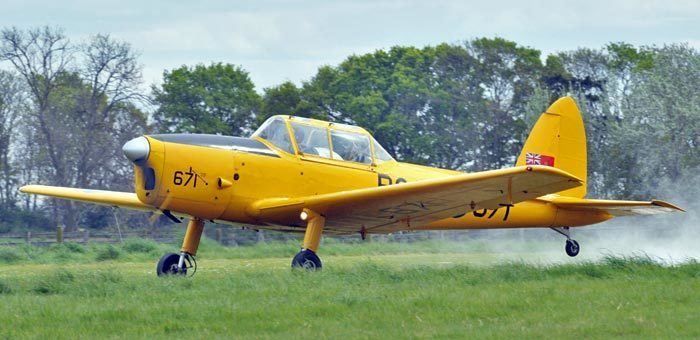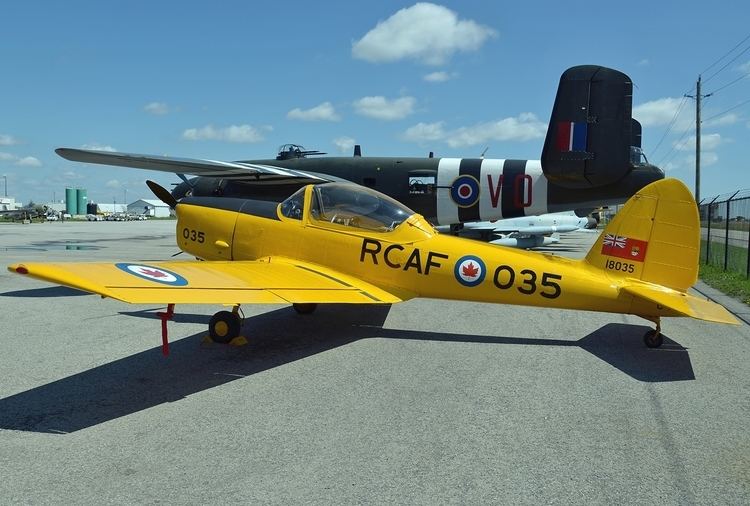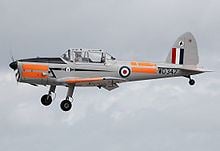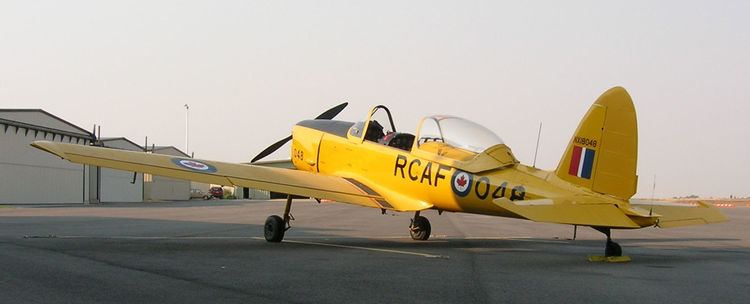Top speed 222 km/h Range 445 km Weight 646 kg First flight May 22, 1946 | Wingspan 10 m Length 7.75 m | |
 | ||
The de Havilland Canada DHC-1 Chipmunk is a tandem, two-seat, single-engined primary trainer aircraft which was the standard primary trainer for the Royal Canadian Air Force, Royal Air Force and several other air forces through much of the post-Second World War years. The de Havilland Chipmunk was the first postwar aviation project of de Havilland Canada.
Contents
- Design and development
- United Kingdom
- Canada
- Production
- Canadian built
- British built
- Portuguese built
- Civil conversions
- Scholl Super Chipmunk
- Civilian operators
- Military operators
- Specifications DHC 1 Chipmunk
- References

Today, over 500 DHC-1 Chipmunk airframes remain airworthy with more being rebuilt every year.
Design and development

The Chipmunk was designed to succeed the de Havilland Tiger Moth biplane trainer that was widely used during the Second World War. Wsiewołod Jakimiuk, a Polish prewar engineer, created the first indigenous design of the aircraft at de Havilland Aircraft of Canada Ltd. It is an all-metal, low wing, tandem two-place, single-engined aircraft with a conventional tailwheel landing gear and fabric-covered control surfaces. The wing is also fabric-covered aft of the spar. A clear perspex canopy covers the pilot/student (front) and instructor/passenger (rear) positions. CF-DIO-X, the Chipmunk prototype, flew for the first time at Downsview, Toronto on 22 May 1946 with Pat Fillingham, test pilot from the parent de Havilland company, at the controls. The production version of the Chipmunk was powered by a 145 hp (108 kW) inline de Havilland Gipsy Major 8 engine while the prototype was powered by a 145 hp (108 kW) de Havilland Gipsy Major 1C.

Three Chipmunk aircraft serial numbers 1, 10 and 11, were evaluated by the Aeroplane and Armament Experimental Establishment (A&AEE) at RAF Boscombe Down. As a result, the fully aerobatic Chipmunk was ordered as an ab initio trainer for the Royal Air Force (Prince Philip took his first flying lesson in one in 1952). The Royal Canadian Air Force also adopted the Chipmunk as its primary trainer.
British-built and early Canadian-built Chipmunks are notably different from the later Canadian-built RCAF/Lebanese versions. The later Canadian-built aircraft have a bubble canopy, while early Canadian, and all Portuguese and British examples have the multi-panelled sliding canopy, the rearmost panels of which are bulged for better instructor visibility.

From the 1950s onward, the Chipmunk also became a popular civilian aircraft, being used for training, aerobatics and crop spraying. Most civilian aircraft are ex-military.
A cabin development of the Chipmunk with side-by-side seating was designed as the DHC-2, but not built.
United Kingdom

The RAF received 735 Chipmunks, designated de Havilland Chipmunk T.10, manufactured in the UK by the de Havilland parent company to Air Ministry specification 8/48 as a Tiger Moth replacement. Production began at the DH Hatfield factory but soon transferred to their plant at Hawarden Airport, Broughton near Chester. They initially served with Reserve Flying Squadrons (RFS) of the RAF Volunteer Reserve (VR) as well as the University Air Squadrons. Chipmunks were pressed into service in Cyprus on internal security flights during the conflict in 1958. Eight disassembled aircraft were flown out in the holds of Blackburn Beverley transports. After reassembly, they operated as 114 Squadron for some months into 1959. From 1956 to 1990 the Chipmunks of the RAF Gatow Station Flight were used for covert reconnaissance by BRIXMIS over the Berlin area. Chipmunk T.10s were also used by the Army Air Corps and Fleet Air Arm for primary training.
Chipmunks remained in service with ATC Air Experience Flights until 1996 (the final AEF to use the Chipmunk was No. 10 Air Experience Flight, RAF Woodvale) when they were replaced by the Scottish Aviation Bulldog. The last Chipmunks in military service are still operated by the British historic flights – the RAF Battle of Britain Memorial Flight (including one of the Gatow aircraft), the Royal Navy and Army historic flights, to keep their pilots current on tailwheel aircraft. The cockpit sections of some former RAF Chipmunks have been used as ground training aids. These are colloquially known as "Chippax" trainers. .
Canada
The RCAF accepted its first DHC-1 Chipmunks in 1948, as the first of a long production run of the 217 Chipmunks made in Canada. The Chipmunk was the first Canadian-designed aircraft to be made abroad under licence, with the majority of the home-grown production destined for the RCAF, but Canadian Chipmunks were also sent to Egypt, Lebanon and Thailand.
Of the 113 in RCAF service, 79 Chipmunks were assigned as ab initio trainers with 34 assigned to flying clubs for use in refresher training for RCAF Reserve pilots. The last example remained in service as a CF trainer until 1972, three years after unification in 1968. The Chipmunk's long service was due, in part, to its fully aerobatic capabilities and superb flying characteristics, which made it a delight to fly. It is also a mechanically sound aircraft and, consequently, many ex-RCAF Chipmunks are still operational around the world.
Landing his Chipmunk at Pearson International Airport in Toronto, Ontario, Canada, on 2 June 2015, retired de Havilland Canada test pilot George Neal set the world record for oldest active licensed pilot at the age of 96 years 194 days.
Production
Downsview built 217 Chipmunks, the last in 1956. A total of 1,000 were built in Britain initially at Hatfield Aerodrome and then later at Hawarden Aerodrome. A further 66 Chipmunks were licence-manufactured by OGMA (Oficinas Gerais de Material Aeronáutico), at Alverca from 1955 to 1961 in Portugal for the Portuguese Air Force.
Canadian-built
British-built
Portuguese-built
Military version powered by de Havilland Gipsy Major 10 Series 2 (145 hp) engine, 10 built in UK followed by 66 built by OGMA. From 1989 onward, seven aircraft where updated and modified at OGMA (5) and Indústrias Aeronáuticas de Coimbra (2) to be used by the 802 Sqn. "Águias" (Eagles) — Air Force Academy squadron. The main modification was the installation of a more powerful 180 hp Continental engine. Their main tasks are related to supporting the Air Force cadets aerial activities, mainly initial aptitude screening, glider tow and initial flight proficiency.
Civil conversions
Scholl Super Chipmunk
A number of Chipmunks were modified as aerobatic aircraft in the United States as the "Super Chipmunk". Along with an uprated engine, the aircraft underwent an extensive makeover including clipping its wings, adding retractable landing gear, conversion to a single-seat layout, adding an autopilot and being fitted with a red, white and blue wingtip and tail smoke system. The control stick received a three-inch (76 mm) extension for greater control during extreme aerobatic maneuvers. For over 25 years the Super Chipmunk in its distinctive bright colour scheme of blue stars and sunburst effect was displayed by the aerobatic pilot Art Scholl.
Four Super Chipmunk conversions were modified, Scholl's N13A and N13Y, Harold Krier’s N6311V and Skip Volk's N1114V. Another more recent "Super Chipmunk" was converted by air show performer, Jim "Fang" Maroney who similarly modified an ex-RCAF example by strengthening the airframe, replacing the original 145 hp (108 kW) engine with a 260 hp (190 kW) version incorporating an inverted fuel and oil system, clipping three feet off the wings and adding 30% more rudder and 10% more elevator. A spatted landing gear was retained. Another similarly modified "Super Chipmunk", N1804Q, is owned and flown by air show pilot Greg Aldridge. N13Y is now on display at the National Air and Space Museum, Smithsonian Institution, Udvar-Hazy Center at Washington-Dulles International Airport., while N1114V is preserved at the EAA AirVenture Museum at Oshkosh, Wisconsin, USA.
Civilian operators
Today, the Chipmunk remains popular with specialized flying clubs and is also operated by private individuals located in many countries worldwide.
Military operators
Specifications (DHC-1 Chipmunk)
Data from The de Havilland Canada Story
General characteristics
Performance
